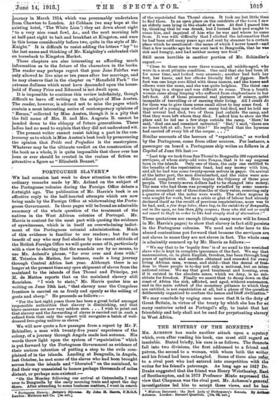THE MYSTERY OF THE SONNETS.*
Mn. ACHESON bas made another attack upon a mystery which, even after reading his book, one must still regard an insoluble. Stated briefly, his case is as follows. The Sonnets fall into two divisions, the first addressed to a friend and patron, the second to a woman, with whom both the writer, and his friend had been entangled. Some of them also refer, to a rival poet who had entered into competition with the for his friend's patronage. As long ago as 1817 Dr. Drake suggested that the friend was Henry Wriothesley, Earl- of Southampton, and in 1873 Professor Mint° expressed the view that Chapman was the rival poet. Mr. Acheson's general' investigations led him to accept these views, and he hai • Mistress Daienant : • the Dark Lady of Shakespeare's Sounds. By Arthati Acheson. London : Bernard Quaritelh Ll0s. 6d, net.]
already published a volume in which he elaborated Minto's theory. In this same book he laid considerable stress upon the suggestion of another critic that the poem known as " Willobie his Avisa," the authorship of which has long perplexed scholars and had been attributed by some to Southampton, was in reality a satire directed against Southampton and Shakespeare. The next link in the chain is the attribution of " Willobie his Avisa" on stylistic grounds to Mathew Roydon, a friend of Chapman's. Mr. Acheson then elaborates the theory that this poem forms one of a series of satirical poems which were aimed at Shakespeare by Chapman and his friends, and answered by Shakespeare in his plays. He further attempts to show that the subject of the poem is the intrigue in which Shakespeare, Wriothesley, and the dark lady were involved, and which forms the subject of the Sonnets. The form of the poem certainly suggests that the author wished people to look for personal references in it. It appeared with a preface by " Hadrian Dorrell " (a name otherwise unknown) stating that it was taken from the papers of Master Henry Willobie, the writer's friend and chamber fellow, and published without his leave. The poem describes numerous attempts made upon the virtue of the beautiful and chaste " Avisa," and makes considerable mystery out of the question whether Avisa is a real person or not. In a curious passage the writer says, " Whether my author •linew or beard of any such I cannot tell, but of mine own knowledge I dare to swear that I know one, A.D., that either bath or would, if occasion so offered, endure these and many greater temptations with a constant mind and settled heart." The theory really depends, however, on the cantos which describe the suit of " H. W." for the favours of Avisa. The lady is spoken of as living at " Yonder house where hangs the badge Of England's knight."
Another passage makes her place of residence the West country, and H. W. is encouraged in his pursuit by " his familiar friend W. S., who not long before had tried the curtesy of the like passion, and was now newly recovered from the like infection." The last link in the chain is the tradition preserved by Anthony Wood and Aubrey of Shakespeare's intrigue with Jane Davenant, wife of John Davenant of the Crown Inn, Oxford, and mother of Sir William Davenant.
Here we have the dry bones of the theory. The weak points of it are :- (1) That whether or not the " Willobie his Avisa" is aimed at Shakespeare and Wriothesley, the story of it is not really at all suggestive of that outlined in the Sonnets.
(2) That the preface to the poem speaks of " A. D.," whereas Mrs. Davenant's name was Jane. Mr. Acheson gives no satis- factory solution of this difficulty.
(3) It is difficult to get over the dedication of Thorpe's edition of the Sonnets (the original edition of 1609) to "Mr. W. H." their " only begetter."
(4) It seems unlikely that Roydon should have published this attack on Southampton at the date when, according to Mr. Acheson, his friend Chapman was making his first attempt to secure that nobleman's favour.
However, there is no doubt that Mr. Acheson has discovered a number of curious coincidences. Into all the ramifications of his theory it is impossible to follow him, nor would there be much profit in doing so, for, like all theorists of this kind, he cannot resist the temptation of strained analogies and far- fetched hypotheses. This volume is, however, only an instal- ment of a more elaborate investigation in which our author promises to deal at length with the intrigues of the rival schools of poets, the traces of the feud to be found in the plays, and the light it throws on their chronology. At present the treatment of this so-called " subjectivity " of the plays is the weak point of the book. Only a sound literary instinct can keep this kind of investigation upon sensible lines, and one doubts whether in Mr. Acheson the instinct is strong enough.















































 Previous page
Previous page